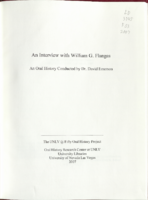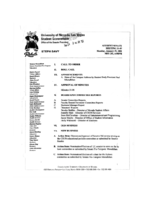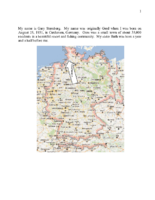Search the Special Collections and Archives Portal
Search Results
Cherina Kleven Papers
Identifier
Abstract
The Cherina Kleven Papers (approximately 1988-2014) document the career of Cherina Kleven who was the first Asian-American appointed as Assistant Fire Chief for Las Vegas Fire & Rescue. The materials primarily include physical and digitized photographs of Kleven in her capacity as Assistant Fire Chief, magazine and newspaper articles featuring Kleven, and event programs. Also included are campaign fliers from 2010 when Kleven ran for office to represent Assembly District 15 in the Nevada Legislature as well as two commemorative books celebrating the history of Las Vegas Fire & Rescue.
Archival Collection
George Kelly Ryan Photograph Collection
Identifier
Abstract
The George Kelly Ryan Photograph Collection (1929) depicts waterways in Southern Nevada and Northern Arizona. The collection consists of eight photographic prints and two photographic negatives depicting Saint Thomas, Black Canyon, Boulder Canyon, and the Colorado River.
Archival Collection
Gue Gim Wah Papers
Identifier
Abstract
The Gue Gim Wah Papers (approximately 1940-1985) consist primarily of incoming correspondence (largely written in Chinese) to Gue Gim Wah at the Prince Mine in Pioche, Nevada. Also included are Wah's naturalization certificate, a map of the Prince Mine Bunkhouse, brochure of the Lincoln County Civic Association, and a small amount of photographs including a black-and-white photograph of Gue Gim circa 1940s.
Archival Collection
George Kelly Ryan Papers
Identifier
Abstract
The George Kelly Ryan papers (1921-1971) contain correspondence inquiring about Octavius Decatur "O. D." Gass, newspaper clippings from 1929, handwritten recollections of the Gold Ranch by Laura Royce, and a San Pedro, Los Angeles and Salt Lake Railroad Company information, including information on wash-outs in Nevada.
Archival Collection
Albert S. Henderson Photograph Collection
Identifier
Abstract
The Albert S. Henderson Photograph Collection (1860s-1959) primarily contains black-and-white photographic prints of Albert S. Henderson and his family. Also included in the collection are photographic prints of Henderson during his tenure as a Nevada legislator and district judge. Other materials include postcards, negatives, and a tintype.
Archival Collection

Transcript of interview with William G. Flangas by Dr. David Emerson, September 27, 2006
Date
Archival Collection
Description
Text

Meeting minutes for Consolidated Student Senate, University of Nevada, Las Vegas, January 29, 2001
Date
Archival Collection
Description
Text

Biographical essay by Gary Sternberg, 2014
Date
Archival Collection
Description
Gary Sternberg grew up in Germany, witnessing anti-Semitic propaganda as early as age 7. He describes some of the experiences his father endured at a concentration camp, and his escape to China. He and his mother reunited with his father in Shanghai in 1940. They left Shanghai in 1948, eventually settling in Cleveland. He and his family came to Las Vegas in 1969.
Text

Meeting minutes for Consolidated Student Senate University of Nevada, Las Vegas, Febuary 14, 1985
Date
Archival Collection
Description
Text

